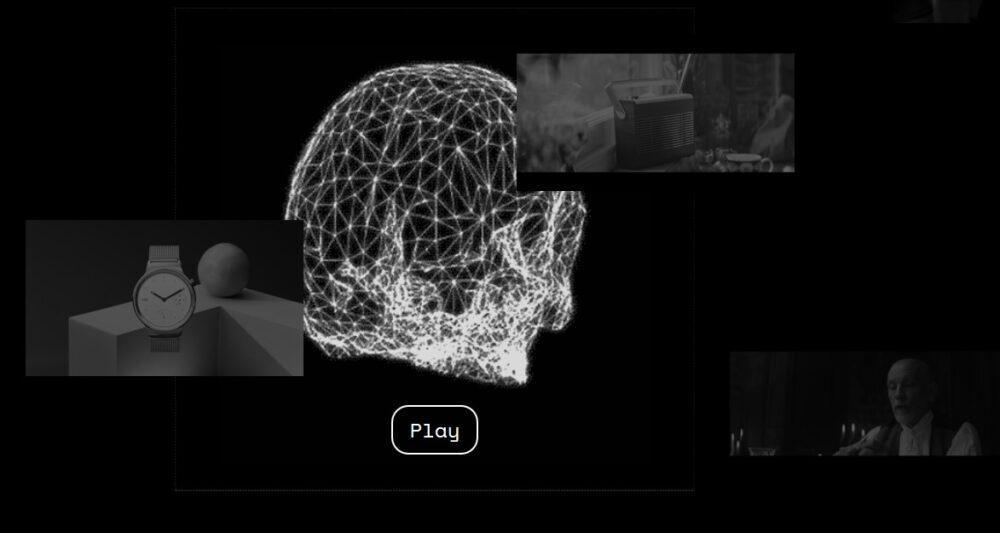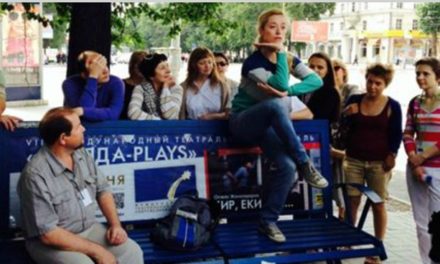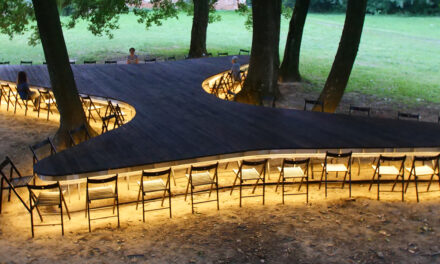Have the worlds of Samuel Beckett’s plays become our reality? The creators of Beckett Planet seem to answer this question in the affirmative revealing a number of parallels between the fictional and the real in seven filmed theatre pieces based on Beckett’s Rough for Theatre I, Catastrophe, Rockaby, Play, Endgame, Not I and What Where. Their selection of plays and staging, however, suffer from two serious problems: repetition and lack of innovation. On top of that the technical side of the productions, always vital for online projects, creates problems in the reception of both individual etudes and the entire project.
Rockaby, Not I and What Where all make extensive use of repetition, though each does so each somewhat differently. Both include sequences of lines repeated with variations, and this is to a certain point reflected in the visual elements of the productions. In Rockaby, directed by Agata Koszulińska, the sequences are expanded by adding new elements, producing what seems to be an endless repetition of slightly tweaked phrases. This creates a sense of excess and density, intensified by Mateusz Korsak’s 3D animation. The actress speaks the text while a human figure appears on a black background, slowly levitating among various objects, giving the image a hypnotic feel. Over time, body parts materialize among the objects and begin to fuse into increasingly abstract forms. This piece has the potential of transporting the audience into a trance, which evokes the in-between state of being suspended between movement and stillness.
Not I, directed by Katarzyna Minkowska, uses a different kind of repetition: the recurrence of images both in the text and on the screen. The sentences, or rather snippets of sentences, are the starting points from which the narrative develops. The text is fragmented and seems to repeat ad infinitum. This impression is reinforced by recurring, black-and-white close-ups of the actor’s face, intercut with a landscape, and a buzzing fly that periodically appears on screen. The sense of dispersion emerging in both the text and the visual aspects of the piece disturbs the viewer’s sense of time.
A similar thing happens in What Where, directed by Marcin Starosta, but here the visual elements are more varied, even if the looping of image and text remains the principal technique. Although they form a web of repetitive images/memories, the spoken text displays some diversity due to variations in pace and intensity of the voices that at times overlap. Even though the text is structured similarly to that in Rockaby and Not I, the narrative is more dynamic.
Another group of pieces, Rough for Theatre I directed by Jan Kamiński and Endgame directed by Karolina Kowalczyk, involve exchanges between two characters. Shot in black and white and using a split screen, Rough for Theatre I has two actors delivering their lines, creating a – possibly jaded – suspense, in a conversation about everything and nothing. Once again there is a static visual narrative, which allows the characters and language to resonate but at the same time making it like some of the other pieces.
The narrow, uncomfortable spaces in the set of Endgame portray a post-apocalyptic world. The characters establish new relationships of power and subordination between each other, revealing the role that violence plays in that process. Compared to the other pieces, Endgame makes skillful use of variable dynamics. The pauses, dominated by silence, are interrupted by dialogue in which the actors’ voices vary in their intensity.
The other two etudes, Play directed by Jan Jeliński, and Catastrophe helmed by Karolina Szczypek, offer the most creative takes on Beckett’s material. Set in a deserted theatre, Play is a short silent film featuring empty box seats, sound equipment picking up some noises and a sequence of three faces. The filmmakers dispense with dialogue and leave theatre to its own devices. A comedy of absurdities ensues with no audience or words, just the hollow faces of the actors. Catastrophe follows theatre rehearsals with a group of theatre makers struggling with some of theatre’s problems. The first of these problems is power; those in decision-making roles are on the one side and those with no such powers are on the other. The second, funding, is encapsulated by a sentence uttered in the etude, “it’s not about art, it’s about taking money”. These words are an indictment of the system and the artists stuck within it. The closing credits are the payroll: from the highest payout (the curator’s 9,700 PLN) to the lowest one (0 PLN for editing). The rehearsal room where the action takes place is filmed statically, as in most of the Beckett Planet etudes.
The recurrence of certain devices – a static camera, recurring images, filming in black and white – becomes meaningful when we consider that the pieces are intended to form a whole. Interactive elements are also significant. Audience participation is not a novel concept, but amid the coronavirus pandemic the question of involving the audience, who are not in the auditorium but in front of their screens, seems more problematic and complex.
There are tools given to the viewers, which are intended to add an element of interactivity such as the possibility of choosing the viewing order and to leave comments. However, they fail to meet one of the fundamental conditions of interactivity, the emergence of new meanings from a fusion of elements. Although the comments are a testament to the presence of an audience, they do not become an integral element of the work as they are not embedded in the performances. Choosing the order the films are watched proved difficult, too. Scattered in the centre of the screen, the rectangles corresponding to individual pieces are hard to arrange as nothing really indicates which is which. Only a few of the rectangles are labeled with titles. The viewers have to make their choice at random, which limits their agency.
The website is problematic as well, as it makes viewing difficult. The animation of a white brain rotating against a black background, a skull and other elements are more of a distraction than anything else. This contrast-laden, perpetually moving image blurs into the films, especially the black and white ones (Rough for Theatre I and parts of Not I and Catastrophe). The static etudes melt into the animated backdrop. To watch a film, you move the pointer over one of seven rectangles. The selected screen becomes slightly enlarged, so you see a small area, which cannot be enlarged and is dominated by the moving background. Even assuming that the strategy of distraction is meant to strengthen the impact of the etudes, which after all, tackle pandemic disarray, it does seem somewhat amiss. Instead of an alternating tension between the audience’s concentration and distraction, which would enable active reception, these two states constantly and statically diverge.
Beckett Planet compels us to ask at least three questions. Can the participation framework designed by the creators work effectively through their chosen strategies of using online space, including on the technical level? Are the similarities of the artistic strategies intended to give the etudes a certain commonality and make us see Beckett Planet as a whole? Or, are they the outcome of the difficulties presented by Samuel Beckett’s work?
Urszula Pysyk is a student of Theatre Studies, Jagiellonian University.
Planeta Becketta (Beckett Planet) at Teatr Polski, Poznań
Premiered online on 19 October 2020
Beckett’s plays in Antoni Libera’s translation; subtitles by Agnieszka Misiewicz; Polish Sign Language translation.
Rockaby, dir. Agata Koszulińska; Endgame, dir. Karolina Kowalczyk; Not I, dir. Katarzyna Minkowska; Catastrophe, dir. Karolina Szczypek; Comedy, dir. Jan Jeliński; Rough for Theatre, dir. Jan Kamiński; What Where, dir. Marcin Starosta
Curators: Maja Kleczewska, Łukasz Chotkowski
The article was first published in Polish in Didaskalia, No. 160, in December 2020. It was translated by Didaskalia into English for TheTheatreTimes.com. To read the Polish text, click here.
Didaskalia is now an open-access journal appearing bimonthly.
This post was written by the author in their personal capacity.The opinions expressed in this article are the author’s own and do not reflect the view of The Theatre Times, their staff or collaborators.
This post was written by Urszula Pysyk.
The views expressed here belong to the author and do not necessarily reflect our views and opinions.


















